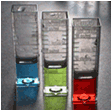Additional copy to go in here, if needed etc.
 Are your fish acting strange or looking unwell?
Are your fish acting strange or looking unwell?
Well then the very first thing you should do is test your water.
Poor water quality can be extremely toxic for our fish. Unfortunately most Koi keepers learn by their mistakes. “I've had this pond for years, why do I need to test my water” until one dreaded day something goes wrong!
Good water is the key to good Koi keeping.
Although you might think it sound simple, controlling the complex environment for our Koi is not straight forward, the chemical make up of our pond water is far from it. There are plenty of detailed books on the market explaining water quality in detail – but for now here is a simple explanation.
Koi produce Ammonia from their waste and gills. It is extremely toxic for them. The nitrogen cycle helps break this down.
A simple version of the Nitrogen cycle:
Koi waste, uneaten food, dead plants etc. = Ammonia the first stage of natural bacteria (mainly Nitrosomonas) breaks down the ammonia into Nitrite the second stage of natural bacteria (mainly Nitrobacter) converts the Nitrite into the less harmful Nitrate.
Pond testing kits are readily available in all kinds of various forms at most aquatic centres.
So what essential tests do I need to do?
1. Ammonia (NH3 / NH4+) Toxic to Koi, tests should always read zero.
2. Nitrite (NO2-) As above toxic to Koi and tests should always read zero.
3. pH Test for acidity or alkalinity (Values of 7.0 to 8.5 is normally ideal)
High ammonia / nitrite levels may be down to an new filter system, which can take up to 4 months to mature. Also over feeding or over stocking may be the cause.
If you are continually experiencing high levels of ammonia or nitrite, it normally means your Koi and feeding program are producing more ammonia then the biological filter system can handle. You need to take immediate action – Cut down feeding and carry out a partial water change (use de-chlorinated water). Clear your pond of debris (uneaten food and leaves etc.) Also increase the aeration if possible. Please note if you have any problems with high readings, it is always better to consult your local Koi dealer for individual needs.
How often should I test?
I recommend testing for ammonia, nitrite and pH every week. However if problems occur, you may need to check more often.
Always keep a record of your tests.
What other tests are worth doing?
4. Nitrate (NO3-)
5. Dissolved Oxygen (O2)
6. General Hardness (GH)
7. Carbonate hardness (KH)
8. Chlorine
728x90
leaderboard
120x600
skyscraper
728x90
leaderboard

